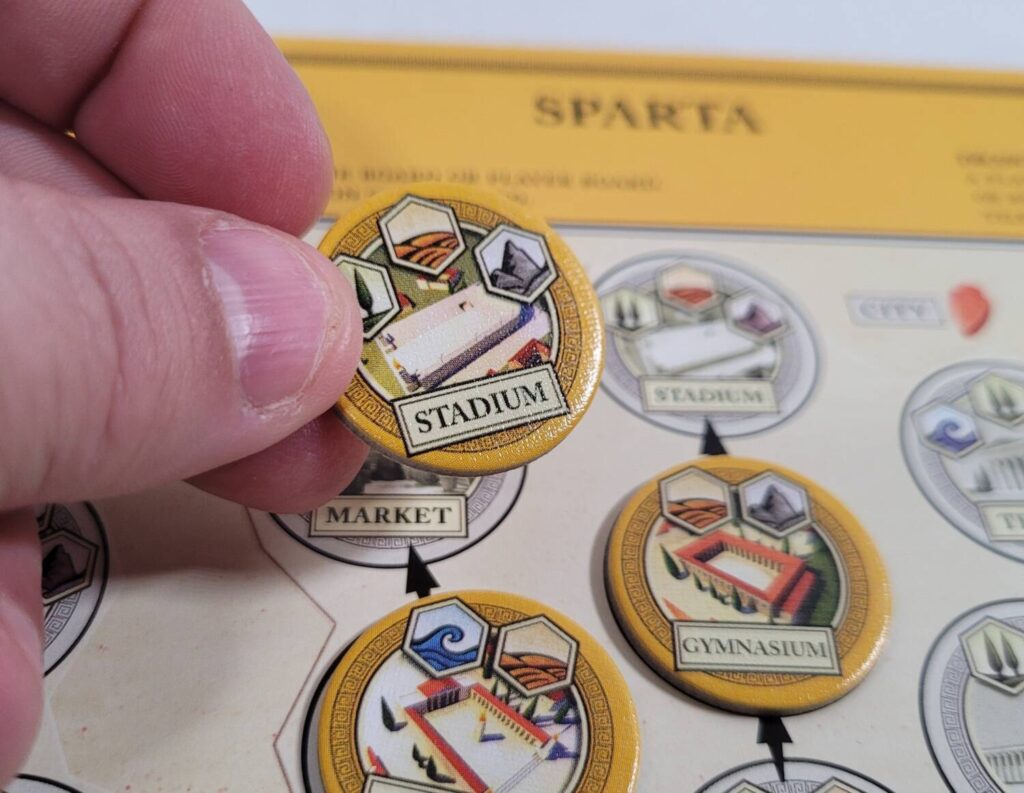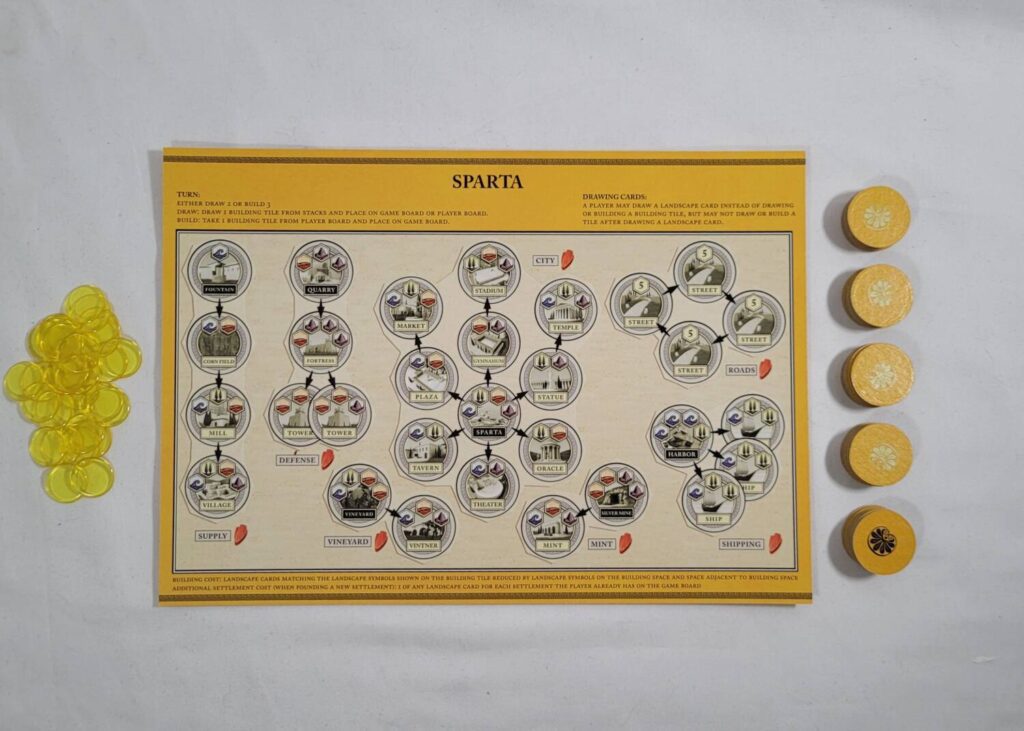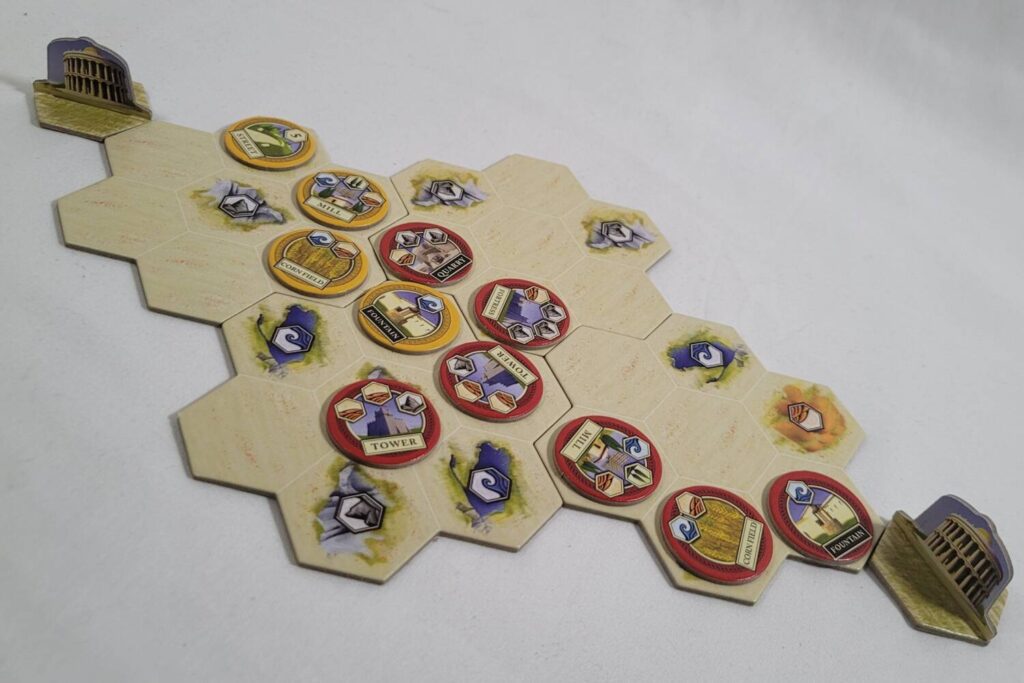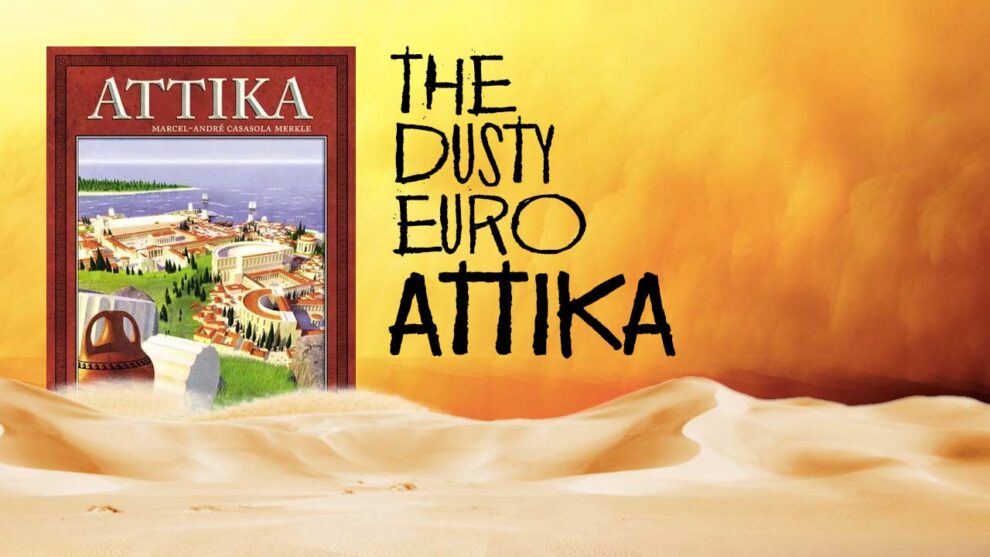When the guys in Justin’s Wednesday gaming group started a push to play more of the old, dust-covered games at the bottoms and backs of their respective game closet shelves, the Dusty Euro Series was born. The premise was simple: let’s try to remember why we keep all these old games when all we ever play now are the newest, shiniest things in shrink.
In order to share some of these experiences, we’ll be writing a piece from time to time about a game that is at least 10 years old that we haven’t already reviewed here at Meeple Mountain. These articles are not reviews. These pieces will not include a detailed rules explanation or a broad introduction to each game. All you get is what you need: our brief thoughts on what we think about each game right now, based on one or two fresh plays.

Attika: What Is It?
Attika was published in 2003 by Hans im Glück and Rio Grande Games (the version that I own). The game was designed by Marcel-André Casasola Merkle who is known for his other games such as Pyramid of Pengqueen, Santa Cruz, and Taluva and less well known for the very obscure Attribut 2 which I only mention here because he co-authored it with Uwe Rosenberg, one of my all time favorite designers and the focus of my Ave Uwe series of reviews.
Looking at the game, you can practically see the dust. With its classic maroons, beiges, and olive greens, Attika is not going to be winning any beauty contests. The component quality is designed for functionality: thin player boards, thin cardstock, and a simple bi-folded rules sheet. Produced at a time where production value wasn’t as important as the thing being produced, the game shows its age.
In Attika, the goal is simple: using your Building tiles, be the first to connect one of the game’s shrines to another of the game’s shrines. The actual method of achieving this goal? Not so simple. The game board is composed of several interlocking, roughly hexagonal tiles. Some of these tiles feature iconography that matches up to the four landscape types present in the game: water, forest, hills, and mountains. During their turns, players will be given the opportunity to draw a Building tile from one of several personal, face down stacks and then play it by paying its cost—some combination of landscape types (which can be paid for by discarding matching landscape cards)—discounted by placing the tile in a position such that it borders, or covers, one or more of the matching landscape types.

But, wait. There’s more. Central to the game is the concept of Building groups and building order. Each Building tile belongs to a specific Building group, and these are arranged within the group in a certain order. If you’ve constructed a Building tile of a group already and the black arrow from that previously constructed building on your player mat points at the Building tile you’re holding in your hand, you can simply build that tile for free.
Planning for such an eventuality and using it to your advantage can help you quickly expand across the map to work toward your end goal of connecting two shrines together. But, more importantly, it can help you in your efforts to cut off your opponent from doing the same. As your tile stacks run out, you’ll be able to introduce more game board tiles to the game, expanding the potential building sites and introducing alternate routes for subverting your opponents’ defensive efforts.
A Step Back in History
I first stumbled upon Attika when I was working my way through the catalog of games on Yucata, and I was instantly smitten. Attika quickly grew to be one of my favorite offerings on the site. So, a year or so ago when I saw a copy of it come up for sale at a local flea market, I jumped at the chance to add it to my collection. And, there it festered for almost a year, waiting for its day in the sun.
That day finally arrived—after filling my game bag with a few games I hoped to play at my game group, I noticed there was still room for another. Casting about for a game to fill the gap, my eyes landed upon Attika, and in it went. Much to my surprise, it actually made it to the table, my first time ever playing a physical copy of the game.

Prior to playing my physical version, I wasn’t aware of just how much bookkeeping the app handles—the stacking of the tiles during setup, the marking of the tile locations on your mat as tiles are constructed and added to the playing area, the colored borders around tiles you’ve already built so you can quickly determine which tiles belong to whom, the enforcement of the rule that makes you have to spend an extra resource when building tiles that aren’t connected to your other ones, and the clear indication of which tiles belong to which groups when you draw them—and I gotta say, it’s definitely missed. It’s not that keeping track of these things is particularly difficult. It’s just that it’s hard to remember to do them when you haven’t had to do them before.
Equal parts strategy and push-your-luck, Attika is just as amazing in person as it is online. The agonizing decisions are still there: when to draw cards as opposed to playing tiles, whether to play a tile immediately or hold on to it in the hopes of chaining it with other tiles in the future, when to block, where to block, where to place new map tiles in an effort to circumvent someone else’s attempts to block you. Despite its simple rules set—the rule book is an entire four pages long—there’s a LOT to think about.
I’m glad that I bought this one. As much as I enjoy playing it online, there’s no substitute for human interaction. I look forward to the next time I’m able to get it to the table.











I think Attika is a real unsung gem, and I’ve hung on to my copy for over a decade now despite lots of newer, shinier titles filling the shelves next to us. Glad to see it hit the table for you and glad to see it get some publicity!